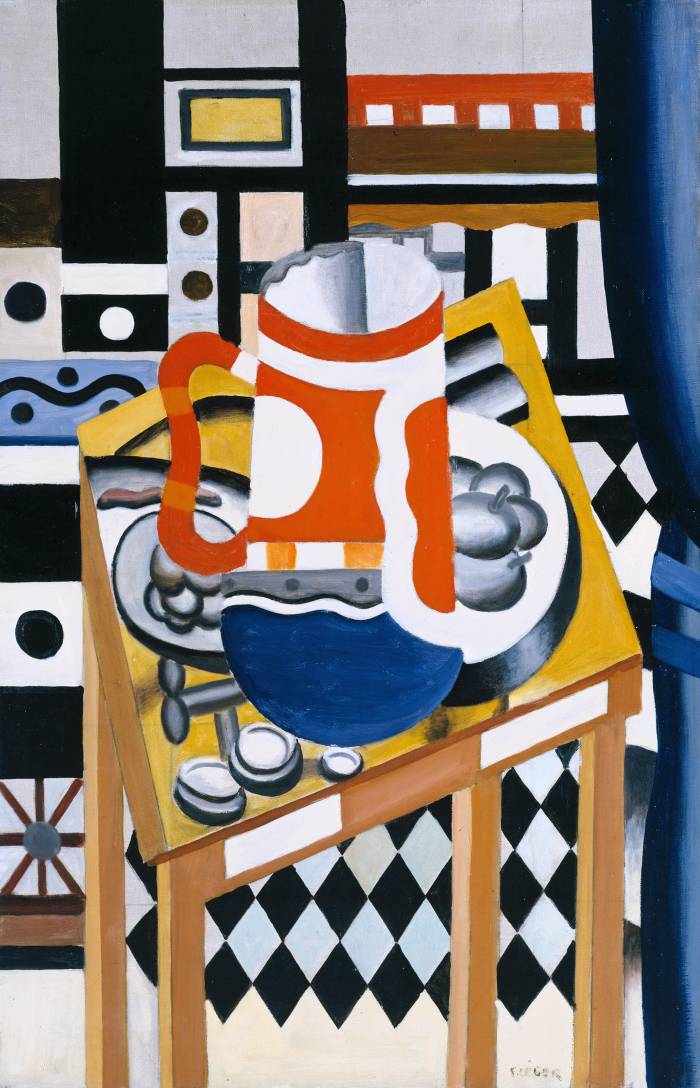Fernand Léger
Still Life with a Beer Mug

Fernand Léger, Still Life with a Beer Mug 1921-2 © ADAGP, Paris and DACS, London 2002
Orientation
This vibrant, bold oil painting has a strong visual impact, largely because it is painted using predominantly black, white and the three primary colours – red, yellow and blue. Dominating the centre of the painting is an overly large German style beer mug with a handle seen in profile on the left. It dwarfs the small, square table on which it sits. The table has exaggeratedly long thin legs that disappear off the bottom of the canvas and it stands on a black and white chequered floor. Surrounding the beer mug are what appear to be two plates of fruit, some small pots of butter and an object that could be a cork-screw. The objects in this painting are quite hard to read, because Léger has radically simplified their forms, reducing them to simple shapes. He has also used several different viewpoints at once and filled every inch of the canvas with a riot of highly coloured, contrasting geometric patterns. Some of these seem to correspond to surfaces in the painting, like the chequered floor, but most seem to be used simply for bold decorative effect. Finally, running down the right hand side of the canvas is a blue curtain tied back half way down its length.
Artist Background
Fernand Léger initially trained as an architect. He was part of the avant garde circle of artists working in Paris at the beginning of the 20th century. Prior to the First World War, his work was strongly influenced by Cubism. He also shared Futurism’s fascination with technology, machinery and the increased speed with which modern life was being lived. Léger developed his own style by combining elements of both movements. His paintings centred on powerful contrasts of forms and although his subjects were often abstracted, fractured and seen from multiple viewpoints, they always remained visually legible. His paintings highlighted the volumetric qualities of objects by simplifying forms into tubular structures and reducing colours to monochromes, primaries and secondaries. Léger’s intention was to conjure up the intense and often unsettling experience of modern life itself with the visual dissonance of his colour contrasts. He wanted his art to have a similar physical effect to speed and noise.
In 1916 whilst fighting at Verdun, he was gassed. Throughout the war he continued to draw and paint. Even in the midst of conflict he could appreciate the formal beauty of the modern machinery of war, such as heavy artillery guns. His wartime experiences had a profound effect on his art. Having served alongside men from all sections of society, Léger came to believe that his art should be accessible to everybody. He wanted his paintings to be instantly recognisable and engage with everyday urban life, so whilst remaining engaged with avant-garde practice, his paintings became less abstract. In the twenties his style changed again, this time influenced by the De Stijl movement and artists such as Mondrian. Their paintings were totally abstract, used only horizontal and vertical lines and had a severely restricted palette of black, white and the primary colours. Although Léger’s work was never totally abstract, he adopted this stricter palette and his mechanistic compositions became extremely precise and ordered. He also explored a number of kaleidoscopic themes in the 20s including propellers and circuses, which re-introduced the human figure into his paintings.






